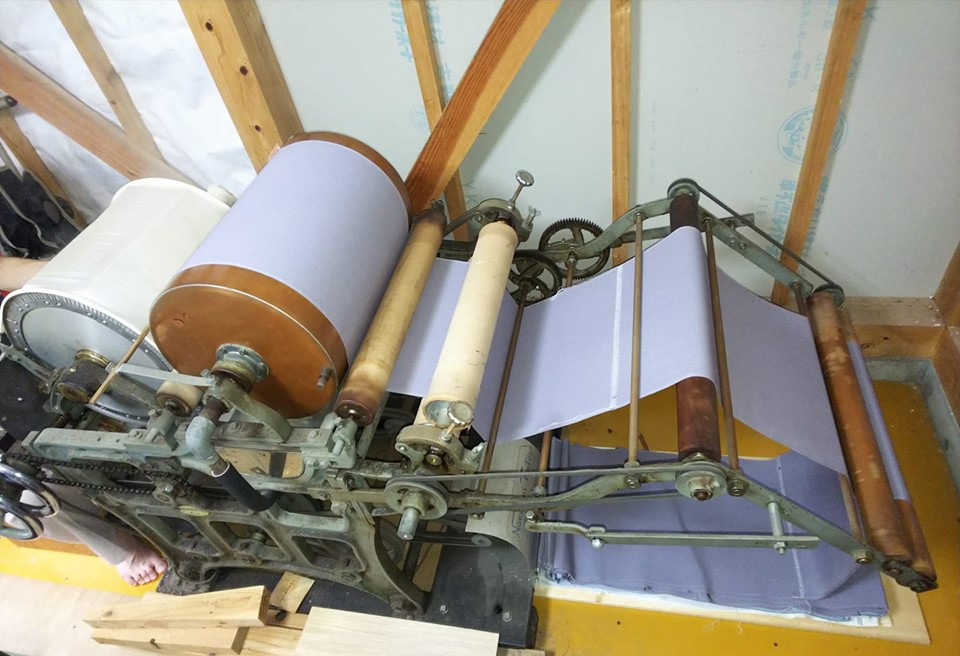幅を揃える
着物の水洗いと言えば、 ″洗い張り“ と言う加工をまず、思い浮かべます。
着物が、全体に汚れているとか、シミが多すぎとか、自分の体に合わなくなってきたり、他人に譲ったり、染め直しをしたり、等々。着物全体をやり直す時に必要とする加工です。一度、着物を解いて反物の状態に戻し、洗剤を付けて、ブラシでこすり全体を水洗いをすることを言います。
丸洗いと区別すると、仕立て上がりのままの状態で洗う事を、丸洗いと言います。
洗い張りは、反物の状態に戻して洗いますので、後に、仕立て直しが必要になります。その仕立て直しの時に、裄(ゆき:肩と袖の長さ)とか、丈(たけ:身長)とか、体に合わせて仕立て直します。洗い張りは、水につけますので、少し縮みますので、ゆのし機械にて幅を揃えて後の加工を行いやすくします。
画像は、しわ伸ばしの途中の写真ですが、左側から、反物を送り右側に向かって出来上がりとなります。蒸気で伸ばしながら幅を揃え、丸い筒状の物でアイロンの代わりを行い、冷やしながら先へ送り、蛇腹織(じゃばらおり)で仕上げとなります。しわ伸ばしの工程ですので、しみ抜きなどは、別加工となります。
今現在は、機械で幅出し(幅をそろえる事)もできますが、昔は、伸子針と言う先に針が付いている庇護(ひご)を使ってやっていたようです。
この、機械を使って一番良かったと思う事は、総絞りの反物を伸ばす時です。これは、絞りのゆのしは、大変です。
同業者で経験者した者しかわからない充実したものが、終わった後ににじみ出るものだと思います。
”機械でよかった。これを 手のし などでやったら大変だっただろうに。”
なんて感想が出るんです。そうですよね、一部の経験者の皆様! !(^^)! 頑張っていきましょう。
Align the width
When you think of washing kimonos, the first thing that comes to mind is a process called “Araihari”
Your kimono may be dirty all over, it may have too many stains, it may no longer fit your body, you may want to give it to someone else, you may want to re-dye it, etc. This process is necessary when redoing the entire kimono. This refers to unraveling the kimono, returning it to its cloth state, applying detergent, scrubbing it with a brush, and washing the entire surface with water.
To distinguish it from full washing, washing the garment in its finished state is called full washing.
Washing upholstery is washed after returning it to its cloth state, so it will need to be remade later. When the garment is re-tailored, the sleeve length (shoulder and sleeve length) and length (height) are adjusted to fit the body. Since the cloth is soaked in water, it will shrink a little, so we use a boiling machine to make it even in width and make it easier to process later.
The image is of the process of smoothing out the wrinkles, but the fabric is fed from the left side and moved towards the right side until it is finished. The width is made uniform while being stretched with steam, a round cylindrical object is used as an iron, and the material is sent to the tip while cooling, and finished with bellows weaving (Jabaraori). Since this is a wrinkle smoothing process, stain removal is a separate process.
Nowadays, it is possible to use a machine to set the width (align the width), but in the past, it seems that this was done using a needle with a needle at the end called a Shinko needle.
The best thing about using this machine is when stretching fully drawn cloth. This is difficult to squeeze.
I think there is a sense of fulfillment that only those who have experience in the same industry can understand, and that will be felt after the work is over.
“I’m glad it was a machine. It would have been difficult if he had done it by hand.”
That’s how I feel. That’s right, some experienced people! !(^^)! Let’s do our best.

